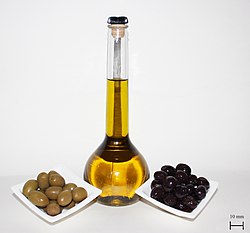**History and Early Cultivation of Olive Oil:**
– Olive oil has been a staple in Mediterranean cuisine since ancient times.
– Wild olives were collected by Neolithic people as early as the 8th millennium BC.
– Olive trees’ domestication origins are unclear, possibly originating in Persia or Mesopotamia.
– Olives reached Greece, Carthage, and Libya around the 28th century BC.
– Evidence suggests olive cultivation in Crete as far back as 2500 BC.
– Olive farming spread to places like Spain and the Roman Empire.
**Symbolism, Mythology, and Composition of Olive Oil:**
– Olive oil symbolizes peace between nations and played religious and social roles in Greek mythology.
– Olive oil is mainly composed of oleic acid (up to 83%).
– Extra virgin olive oil must have no more than 0.8% free acidity.
– Olive oil varies based on cultivar, altitude, and extraction process.
**Varieties and Uses of Olive Oil:**
– Olive cultivars have different flavors, textures, and shelf lives.
– Olive oil is used in cooking, cosmetics, pharmaceuticals, soaps, and traditional oil lamps.
– Olive oil is essential in Mediterranean cuisine and has various culinary uses.
– Olive oil is used in religious practices in Christianity, Judaism, and other religions.
**Extraction and Production of Olive Oil:**
– Olive oil is produced by grinding olives and extracting the oil mechanically or chemically.
– Modern methods use centrifugation for faster and more thorough oil extraction.
– The extraction process ensures olives are perfectly ripened for good quality oil.
– Olive oil production involves transforming olive fruit into paste and different grades of olive oil are produced.
**Global Consumption, Regulation, and Commercial Grades of Olive Oil:**
– Greece has the largest per capita consumption of olive oil at 24 liters per year.
– Spain, Italy, Israel, Canada, and the US also consume significant amounts of olive oil.
– The International Olive Council governs 95% of international olive oil production.
– Various commercial grades of olive oil exist, including extra virgin, virgin, refined, and pomace oil.
Olive oil is a liquid fat obtained by pressing whole olives, the fruit of Olea europaea, a traditional tree crop of the Mediterranean Basin, and extracting the oil.
 Extra virgin olive oil presented with green and black preserved table olives | |
| Fat composition | |
|---|---|
| Saturated fats | |
| Total saturated | Palmitic acid: 13.0% Stearic acid: 1.5% |
| Unsaturated fats | |
| Total unsaturated | > 85% |
| Monounsaturated | Oleic acid: 70.0% Palmitoleic acid: 0.3–3.5% |
| Polyunsaturated | Linoleic acid: 15.0% α-Linolenic acid: 0.5% |
| Properties | |
| Food energy per 100 g (3.5 oz) | 3,700 kJ (880 kcal) |
| Melting point | −6.0 °C (21.2 °F) |
| Boiling point | 299 °C (570 °F) |
| Smoke point | 190–215 °C (374–419 °F) (extra virgin) 215 °C (419 °F) (virgin) 210 °C (410 °F) (refined) |
| Solidity at 20 °C (68 °F) | Liquid |
| Specific gravity at 20 °C (68 °F) | 0.911 |
| Viscosity at 20 °C (68 °F) | 84 cP |
| Refractive index | 1.4677–1.4705 (virgin and refined) 1.4680–1.4707 (pomace) |
| Iodine value | 75–94 (virgin and refined) 75–92 (pomace) |
| Acid value | maximum: 6.6%[inconsistent](refined and pomace) 0.8% (extra virgin) |
| Saponification value | 184–196 (virgin and refined) 182–193 (pomace) |
| Peroxide value | 20 (virgin) 10 (refined and pomace) |
It is commonly used in cooking for frying foods or as a salad dressing. It can also be found in some cosmetics, pharmaceuticals, soaps, and fuels for traditional oil lamps. It also has additional uses in some religions. The olive is one of three core food plants in Mediterranean cuisine, together with wheat and grapes. Olive trees have been grown around the Mediterranean since the 8th millennium BC.
Spain is the world's largest producer, manufacturing almost half of the world's olive oil. Other large producers are Italy, Greece, Tunisia, Turkey and Morocco.
The composition of olive oil varies with the cultivar, altitude, time of harvest, and extraction process. It consists mainly of oleic acid (up to 83%), with smaller amounts of other fatty acids including linoleic acid (up to 21%) and palmitic acid (up to 20%). Extra virgin olive oil is required to have no more than 0.8% free acidity and is considered to have favorable flavor characteristics.
